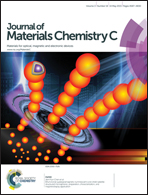Water-triggered spontaneous surface patterning in thin films of mexylaminotriazine molecular glasses†
Abstract
Surface patterning that occurs spontaneously during the formation of a thin film is a powerful tool for controlling film morphology at the nanoscale level because it avoids the need for further processing. However, one must first learn under which conditions these patterning phenomena occur or not, and how to achieve control over the surface morphologies that are generated. Mexylaminotriazine-based molecular glasses are small molecules that can readily form amorphous thin films. It was discovered that this class of materials can either form smooth films, or films exhibiting either dome or pore patterns. Depending on the conditions, these patterns can be selectively obtained during film deposition by spin-coating. It was determined that this behavior is controlled by the presence of water or, more generally, of a solvent in which the compounds are insoluble, and that the relative amount and volatility of this poor solvent determines which type of surface relief is obtained. Moreover, AFM and FT-IR spectroscopy have revealed that the thin films are amorphous independently of surface morphology, and no difference was observed at the molecular or supramolecular level. These findings make this class of materials and this patterning approach in general extremely appealing for the control of surface morphology with organic nanostructures.


 Please wait while we load your content...
Please wait while we load your content...